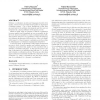Free Online Productivity Tools
i2Speak
i2Symbol
i2OCR
iTex2Img
iWeb2Print
iWeb2Shot
i2Type
iPdf2Split
iPdf2Merge
i2Bopomofo
i2Arabic
i2Style
i2Image
i2PDF
iLatex2Rtf
Sci2ools
SAC
2003
ACM
2003
ACM
Eliciting Coordination Policies from Requirements
Software coordination models and languages describe how agents, resources and processes work together to implement a software system. One of their limitations is that they are used late in the software development and they are not integrated in a typical software development process. What we claim, with our research, is that if coordination becomes explicit and formalized as soon as possible in the life cycle, then it is possible to create coordinated-aware software systems. Moreover, it is possible to verify the adequacy of a Software Architecture (SA) model (or of the code itself) with respect to these dynamic constraints as well as refine or disambiguate coordination requirements themselves. In previous work, we presented a UML-based development process to elicit, describe, analyze and validate system coordination properties that might be then specified with a suitable coordination language. In this general picture, the aim of this paper is to implement the first step, i.e., to ...
| Added | 05 Jul 2010 |
| Updated | 05 Jul 2010 |
| Type | Conference |
| Year | 2003 |
| Where | SAC |
| Authors | Henry Muccini, Fabio Mancinelli |
Comments (0)

